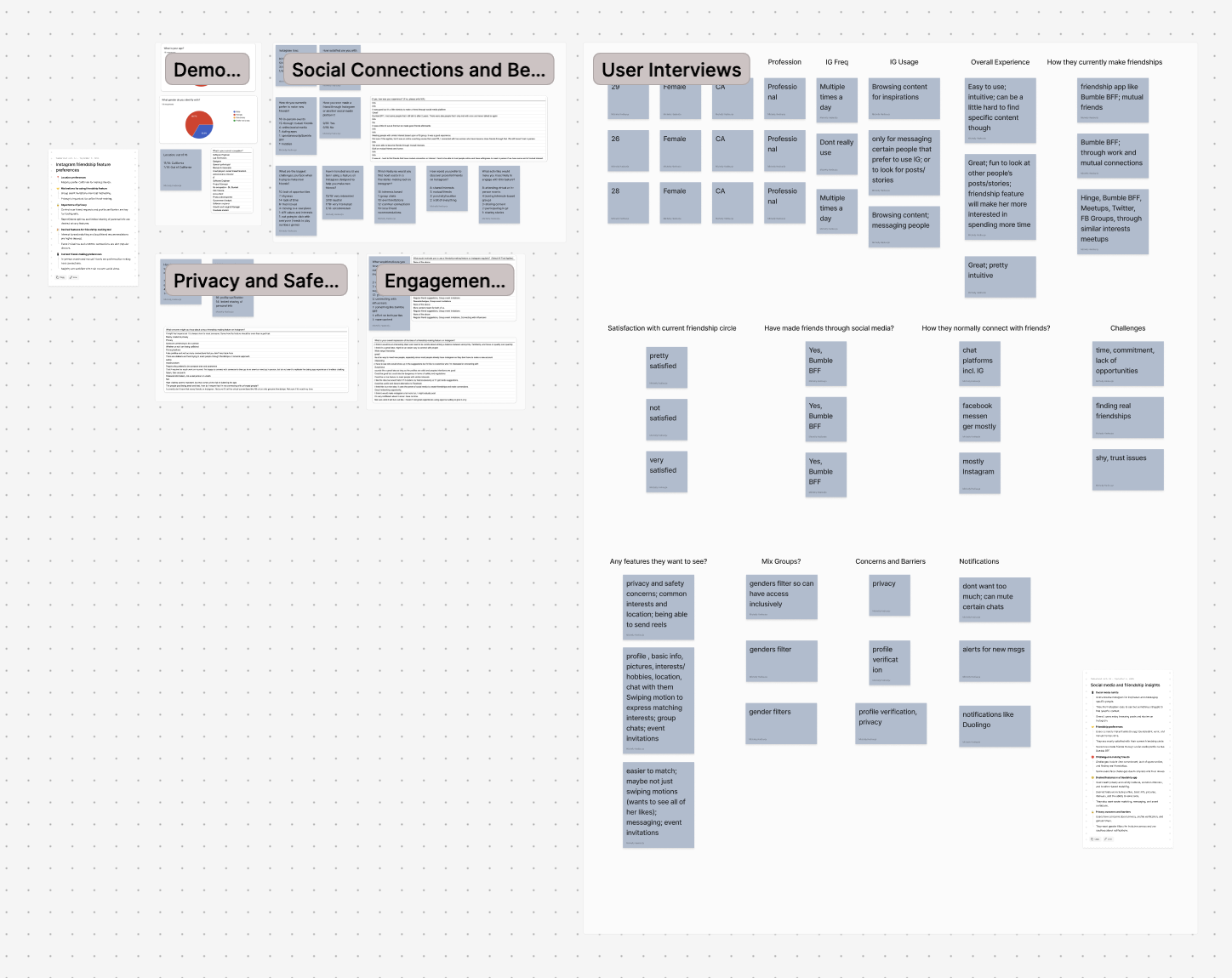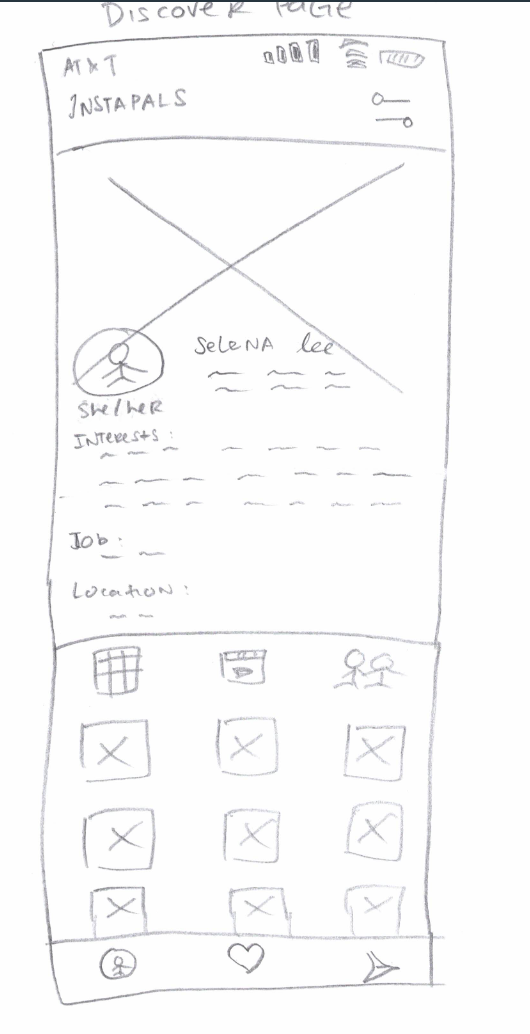InstaPals
Instagram Friendship Feature
Project Type
Add a Feature
Scope of Work
UX Research, UX/UI Design
Tools
Figma, Canva, Adobe Illustrator
Domain
Social Networking, Community & Connection
Client
Personal Project
Date
Sep 2024
Project Overview
Background
After moving back home from college, I found it surprisingly difficult to make new, platonic friendships. While I used Instagram daily, it lacked tools for intentional friend discovery. This personal experience inspired me to design a friendship feature within Instagram—one that helps users connect safely and authentically based on shared interests, not romantic intent.
Problem
Instagram users who are seeking to form new, platonic friendships—especially after life transitions like moving to a new city or returning home from college—struggle to find meaningful ways to connect with others on the platform. While Instagram is widely used for sharing and consuming content, it lacks intentional, interest-based features for discovering new friends. As a result, users are left without safe, structured, or socially acceptable tools to build new relationships within the app.
Goals
Research real user needs and behaviors around friendship-building.
Design an experience that feels natural within Instagram’s ecosystem.
Prioritize safety, consent, and authenticity in every interaction.
“How might we design a friendship feature within Instagram that enables users to form meaningful, interest-based connections—without compromising safety, clarity of intent, or the familiar user experience?”
Key Features
Key Features
The Instagram Friendship Feature enables users to opt into a “Looking for Friends” mode, discover matches through shared interests, and connect via verified profiles and mutual connections. A separate messaging space with icebreakers supports low-pressure conversations, while privacy controls ensure users manage visibility and interactions on their own terms.
-

Research
User Interviews
User Surveys
Competitive Research
Affinity Mapping
-

Define
POV & HMW Statements
User Personas
Feature List
-

Ideate
User & Task Flows
Initial Sketches
Low-Fidelity Wireframes
-

Design
Branding & Logo Design
High-Fidelity Wireframes
Prototyping
-

Testing
User Usability Testing
High Priority Revisions
Research
User Interviews
The primary goal of the interviews was to understand how users currently form new friendships, what barriers they face, and how a platform like Instagram could better support intentional, platonic connections.
Specifically, the objectives were to:
Explore friendship-building behaviors post-college or after moving to a new place.
Identify pain points in using Instagram (or similar platforms) for meeting new friends.
Gauge openness to a friendship feature within Instagram and what it should include.
Uncover expectations around safety, visibility, and authenticity in online social discovery.
Understand what motivates users to connect with new people—and what discourages them.
Participants:
Total: 6 users
Age Range: 18–35
Demographics: Urban dwellers, students, remote workers, digital creatives
Relationship Status: Mostly single, not looking for romantic connections
Instagram Usage: Daily users (1–3 hours/day)
“I moved back home and don’t know anyone here anymore. I wish there was an easy way to meet people that didn’t feel weird.”
Key Insights
Making Friends Online Feels Risky
“I’d love to meet people online, but it’s hard to tell who’s genuine.”
Trust-building signals (mutual friends, verified profiles, shared interests)
Instagram Feels Too One-Way
“I follow people, but I don’t feel like I can meet people here.”
Users see Instagram as a place to watch, not engage personally.
Users want features that invite connection, not just passive consumption.
Users Crave Shared Interest Discovery
“I’d use a friend feature if I could filter by hobbies—like art, hiking, or books.”
Most prefer interest-based filters over location-only filters.
Common desire for subtle prompts or conversation starters.
Skepticism About “Another Dating App”
“It shouldn’t feel like swiping or flirting—I want real friends.”
Users want clear non-romantic framing.
Friendly tone, not gamified or overly curated.
Desire for Control & Boundaries
“I want to control who sees my friend profile—it’s different from my feed.”
Demand for separate profile visibility, opt-in controls.
User Surveys
Trust and Safety
Profile verification, mutuals display
Discoverability
Interests filters, separate profile page
Ease of Interactions
Icebreaker prompts, simple connect buttons
Privacy and Boundaries
Opt-in visibility, report/block features
Platform Consistency
Align visuals with Instagram UI/UX
To validate assumptions from user interviews, gather quantitative data on behaviors and preferences, and understand user openness to a friendship feature within Instagram.
Overview:
Total Respondents: 19
Age Range: 18–34
Gender: 61% female, 35% male, 4% non-binary/other
Location: Mostly U.S., urban and suburban
Platform Usage: 87% use Instagram daily
Key Insights
There’s strong interest, especially among users new to cities or looking to expand social circles beyond existing friends (79%)
Users prioritize values and hobbies over proximity alone. Filters by interest are more important than geography (83%)
Users want transparency, safety controls, and clear framing that this is not a dating feature
Interested features:
Interest filters
Profile verification
In-app chat (separate from DMs)
Icebreaker questions
Separate friendship profile
Affinity Map
As I synthesized the affinity map with the foundational findings that I’ve gathered, I paid particular attention to the challenges people face with making friends post-college and beyond.
Highlights:
Users are wary of the feature being misinterpreted as romantic.
Privacy, profile visibility, and safety are core concerns.
Users struggle to discover new people without a mechanism for interest-based browsing.
Common ground fosters better connections.
Users want easier, more natural entry points to connect.
Design Opportunities
Define
After collecting data and insights from my interviews and surveys, I decided to dive a bit deeper to compile a couple of ‘Point of View’ (POV) and ‘How Might We’ (HMW) statements to understand and highlight the pain points that users see in order to create better user personas. The statements that I crafted from my research are as follows:
POVs
A 25-year-old who just moved back home from college, needs a way to meet new friends in her area because Instagram doesn’t currently support intentional or platonic friend discovery.
A remote worker in a new city, needs a way to connect with others who share his interests, because his current social circle is limited and he feels isolated.
A housewife, needs a way to find safe, non-romantic connections online because she often feels misread or uncomfortable reaching out to strangers on Instagram.
HMWs
How might we help users discover new people based on shared interests or life stages?
How might we make finding potential friends on Instagram feel natural and non-invasive?
How might we ensure users feel safe and in control while being open to new connections?
How might we make initiating a conversation with a new connection less awkward?
How might we provide context or conversation starters to support more authentic engagement?
How might we build trust between users without requiring them to share too much personal info?
After I have clearly defined and articulated my users’ needs and challenges through the personas, the next step of my design process was to compile a list of features that would address those needs.
Key Features:
Friend Discovery Mode
Keeps intent clear and avoids confusion with dating.
Interest-Based Filters
Users can tag hobbies, passions, life stages (e.g., “new to city,” “creative collabs”).
Helps break the ice by matching around shared topics.
Verified Friendship Profiles
Builds trust and reduces spam or inappropriate outreach.
Separate In-App Messaging for Friendships
Chat system distinct from regular DMs to reduce pressure.
Icebreaker prompts or conversation starters available.
Users can choose whether to accept new friend requests or messages.
Mutual Connections Indicator
Builds familiarity and makes new connections feel safer.
These statements help me to develop 3 user personas that will be the center of my design. The two personas consist of a female remote tech-professional, a male person that moved back home after college, and a single-at-home parent that have their own distinct challenges and goals in building new connections. Their pain points that I have uncovered from my research would be the foundational centerpiece of my design as I move forward in my design process.
Ideate
As this project relies on an existing designed site structure, the next step was to create a map out the paths a user might take to complete a task within the website. For this user flow, I stayed focused on three distinct tasks such as:
Finding a Match
Creating Connections
Profile Verification
With these diagrams in hand, I proceeded with the next step of designing the layout of the screens with initial sketches. I took inspirations from well-known social networking sites such as Bumble and Hinge to design a clean and engaging application that can serves and addresses the needs of the users and at the same time staying true to Instagram’s unique design.
In order to confirm the viability and accessibility of my sketches, I moved forward with the design process and started to bring these sketches into a higher-fidelity wireframing. I then seek feedback from some of the users that I have interviewed to ensure that my design makes sense and able to provide the necessary information and actions for users to perform and complete the task.
Design
With mid-fidelity design in place, it was time to come up with the unique and simple icon of the feature.
For the icon, I chose a two-circle smiling icon that can represent the friendly and inviting nature of the friendship feature.
To stay consistent with Instagram brand nature, I followed the color palette and its typography style.
Feature Icon
With the components and the key features all figured out, I moved forward with the creation of high-fidelity model of the application. Using the feedback I’ve received from the user testings, I added a couple more frames to provide instructions of the feature for better accessibility and functionality of the feature.
With these high-fidelity wireframes structured, I developed a prototype in Figma in order to test out the main user flows:
Accessing the friendship feature from their main Instagram profile
Connecting with another user
Messaging with a matched user
-Belonging-Authenticity-Inviting-Community First-
Testing
After the completion of my prototype, I conducted a usability testing with the help of 6 participants. The participants are a mixture of active Instagram users and occasional Instagram users. All users were able to complete each task with a 100% success rate.
Creating an Instapals account within their Instagram profile
Pals Discovery
Interest Tagging and Messaging Experience
Testing Insights:
Users appreciated how the design stays consistent with Instagram platform
Users loved shared interest filters
Some confusion over connection vs. follow
Participants
6 users aged 22–30, including recent grads, remote workers, and users who had recently moved to a new city.
Success Metrics
Achievement Rate: 100%
Avg. Time on Task: 2 min 15 sec
SUS Score: 83.3
Feature Clarity: 4.75/5
Safety and Control: 4.8/5
Likelihood to Use: 4.5/5
Areas for improvement:
Adjusted button labels
Improved onboarding instructions
Conclusion
This project challenged me to reimagine Instagram as a platform not just for sharing, but for building intentional friendships—especially for users navigating life transitions, like moving or graduating.
Through user research, I uncovered the emotional friction people feel when trying to make friends online: fear of misinterpretation, lack of clear intent signals, and the absence of safe discovery tools. By designing a “Looking for Friends” mode, interest-based filters, and respectful interaction flows, I addressed these needs with empathy and clarity.
User testing validated the direction, with high task success, strong usability scores, and positive feedback on safety and feature clarity. One major takeaway was the importance of giving users control and context—from visibility settings to conversation prompts—so they feel empowered, not exposed.
Ultimately, this project deepened my understanding of designing for connection and trust within social platforms. It also strengthened my skills in research synthesis, feature prioritization, and creating user-first flows for sensitive interactions.




















